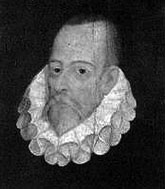Miguel de Cervantes Saavedra
Critique

Born
1547
Died
1616
Publications
Novels, stories, plays
Writing language
Spanish
Literature
• Don Quixote (1605–1615)
Novels
• Don Quixote (1605–1615)
Adventure Fiction
• Don Quixote (1605–1615)
Plays
• The Siege of Numantia (1586)
The first novelist and novel character
Cervantes is acclaimed as the originator of the modern novel, with the publication of the adventures of that archetype of noble dreamers, Don Quixote.
But the Spanish writer is also known as an interesting character in his own right, so much so that the famous dramatic adaptation of his book, the musical Man of La Mancha, features Cervantes himself as a character as much as it does his fictional creation. In the play he is shown in prison (as he really had been confined), creating and acting out with the other prisoners the plot of Don Quixote.
But that was only part of his colourful life.
The son of an unsuccessful doctor, Miguel de Cervantes Saavedra was born into an ancient but impoverished Spanish family. In 1569 he joined the Spanish army in Italy and was wounded in a naval battle in 1571, leaving his left hand permanently crippled. While returning to Spain four years later, he was seized by pirates and held in Algiers until ransomed by friars in 1580.
Back in Spain he married (unhappily) and tried to make a living in Madrid by writing. His first attempt at fictional prose, the pastoral romance Galatea (1585), didn't pay and several plays he wrote were hardly more successful, the best known being a four-act play now considered a classic of Spanish drama, The Siege of Numantia (El cerco de Numancia, first staged in 1586)
He was forced to take a job as a tax collector in Andalusia in 1587. He was repeatedly imprisoned for debt or bookkeeping irregularities.
Legend has it that he was in prison in 1602 in the La Mancha region for failing to give all the collected taxes to the government when he began writing The Ingenious Gentleman Don Quixote of la Mancha (El ingenioso hidalgo Don Quijote de la Mancha), which was published in 1605.
The book was enormously popular. When an unknown writer published a spurious sequel in 1614, Cervantes himself hurriedly wrote a second part to Don Quixote that came out in 1615 and is considered by many to be an even greater work. The two parts are usually published together in a single, long volume.
During this time, Cervantes also wrote other works, including a collection of highly accomplished stories (Novelas ejemplares, 1613); a series of one-act satirical plays (Ocho comedias y ocho entremeses, 1615); and a long tale of fantastic adventure, The Travails of Persiles and Sigismunda (Los trabajos de Persiles y Sigismunda, published posthumously in 1617), which he considered his greatest work.
— Eric
Critique

